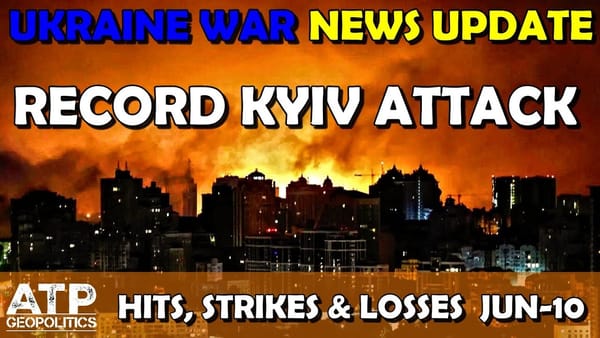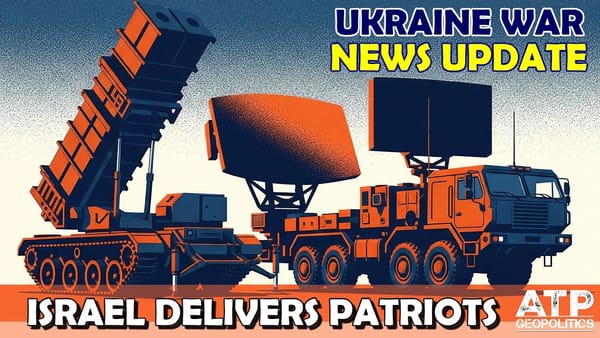Ukraine War Update BUMPER NEWS: Military Aid News - Germany w/ Massive Aid Package
Table of Contents 📖
Hello Team
🎦 00:00-00:15⏩
Jonathan welcomes viewers to another ATP Geopolitics "Ukraine War News Update", highlighting that this is the second part for 28th May 2025. He notes it's a military aid update, featuring significant developments, particularly from Germany.
Return to top⤴️
Germany's Massive Military Aid Package
🎦 00:15-01:28⏩
Jonathan reports on a major military aid package from Germany, announced during Ukrainian President Zelenskyy's visit to Germany.
- Zelenskyy has hailed Germany as the "global leader in supporting Ukraine and the rule-based world order," indicating Germany is now considered Ukraine's biggest formal supporter.
- Initial reports mentioned €3 billion, then rising to €5 billion. The total commitment from Germany is set to increase to €7 billion by 2025.
Details of German Aid: Air Defence and Artillery
🎦 01:28-03:13⏩
Jonathan details the contents of Germany's new aid package:
- Air Defence Systems: Three IRIS-T systems and three Skyranger turrets (mobile air defence systems from Rheinmetall, including the Skyranger 30 and potentially modular versions).
- Artillery: Ten howitzers.
- Vehicles: Twenty armoured vehicles.
- Ammunition: Artillery shells and drones.
Jonathan explains that the Skyranger systems can be mounted on various platforms, including Leopard chassis, or used as modular units.
Return to top⤴️
Germany to Fund Ukraine's Domestic Cruise Missile Programme
🎦 03:13-05:43⏩
A significant development is Germany's commitment to provide technical components and financial support for Ukraine's missile programme, enabling Kyiv to build its own cruise missiles with a range of up to 2,500 kilometres.
- This is confirmed by sources like Politico and German tabloid Bild, and aligns with previous reports that the German government was exploring ways to support Ukraine's defence industry for long-range weapon systems.
- Jonathan notes that this long-overdue step is a crucial development. However, he cynically suggests that German Chancellor Scholz might use this as a reason not to provide Ukraine with Taurus KEPD-350 missiles, estimating that he will feel his duty has been fulfilled.
Germany's Formalised Aid Points and Starlink Funding
🎦 05:43-08:08⏩
The German and Ukrainian Defence Ministries have formalised several key points:
- Germany will fund Ukraine's long-range missile programme, as Ukraine's production capacities were already in place but lacked financing. The first long-range weapons are expected to arrive on the battlefield in the coming weeks.
- New air defence assets worth €2.2 billion, including IRIS-T SLM and SLS firing units and missiles, will be transferred. Jonathan clarifies that this is part of Germany's overall aid package, not Ukraine buying directly.
- The aid also includes financing for satellite communication (specifically Starlink coverage), communication devices for military leadership, artillery ammunition, and medical supplies.
- Chancellor Scholz stated that Germany will extend its commitment in this field and will sign a memorandum for a Ukrainian long-range weapon programme, fostering joint production and military-industrial cooperation.
- Funding for this aid will come from interest generated by frozen Russian assets (around $50 billion) and the German budget.
Rheinmetall's Shell Production and Leopard 1A5 Acquisition
🎦 08:08-10:10⏩
Jonathan reports on Rheinmetall's manufacturing capabilities and a recent deal involving Leopard tanks:
- On the eve of Zelenskyy's visit, Rheinmetall showcased its shell manufacturing facility in Unterlüss, Germany, which produces a wide range of ammunition (155mm artillery, 120mm tank shells, 35mm Gepard ammunition) and barrels for Leopard tanks and Panzerhaubitze 2000s.
- Rheinmetall is set to acquire 71 Leopard 1A5 main battle tanks (with an option for 25 more) from the Swiss company Ruag, which has them stored in Italy. This deal was made possible because Rheinmetall contractually guaranteed not to transfer these tanks or their components to Ukraine.
- Jonathan speculates that these tanks might be used for "ring swaps," where they are given to other countries (e.g., Greece) who then provide their older, Soviet-era tanks to Ukraine. He sees this as potentially good news for Ukraine, even if indirect.
Ukraine's $30 Billion Funding Needs for Arms Production
🎦 10:10-10:33⏩
President Zelenskyy stated that Ukraine needs an additional $30 billion this year to ramp up domestic arms production and sustain its defence against Russia.
- He emphasises that it's not a production capacity issue, but solely a funding issue.
- Zelenskyy is urging the G7 nations to provide this financing and wants to utilise frozen Russian assets to help fund Ukraine's industrial capacity.
European Public Support for Ukraine and Common Defence Policy
🎦 10:34-11:05⏩
A new survey indicates strong European support for common defence and aid to Ukraine:
- A record 81% of Europeans support a common defence policy amid the war.
- Trust in the European Union has reached an 18-year high.
- 59% of EU citizens support the purchase and supply of weapons for Ukraine, demonstrating continued appetite for supporting Ukraine within the EU.
UK Agreement to Use Frozen Russian Assets for Military Aid
🎦 11:06-11:55⏩
The Ministry of Strategic Industries of Ukraine and the UK Ministry of Defence have signed a project agreement on using excess profits from frozen Russian assets.
- This agreement aims to expedite a further $3 billion in 2025-2026 from the UK, using profits from frozen Russian assets to underwrite loans.
- The funds will be used for procuring foreign-made defence products, repairing and maintaining military equipment, and implementing joint projects, further bolstering Ukraine's war effort.
Lifting of Weapon Range Restrictions by Western Allies
🎦 11:56-13:35⏩
German Chancellor Scholz confirmed that there are no longer any restrictions on the range of weapons delivered to Ukraine by the UK, France, Germany, or the US.
- Jonathan notes that Germany has changed how it reports military aid, making it less transparent, which some speculate could facilitate the secret transfer of Taurus missiles.
- However, Jonathan also presents a more cynical interpretation: this announcement might be made because Ukraine has already exhausted its supply of such weapons (e.g., Storm Shadow, SCALP) and Western allies are unwilling to provide more. He points out that ATACMS and Storm Shadow have already been used against targets deeper within Russian territory, not just occupied Ukrainian lands.
Netherlands Completes F-16 Deliveries to Ukraine
🎦 13:36-14:28⏩
The Netherlands has completed its delivery of 24 promised F-16 fighter jets to Ukraine.
- Dutch Defence Minister Ruben Brekelmans stated that these donated jets are "of vital importance" to Ukraine, especially against daily Russian air attacks, and have already saved lives by intercepting cruise missiles and drones.
Sweden's Additional Military Aid Package
14:28-14:40⏩Sweden has allocated an additional €443 million in military aid to Ukraine.
- This funding will support various coalitions and initiatives, including €92 million specifically for Ukraine's defence industry under the "Danish model" of direct support.
EU Considers Purchasing US Weapons for Ukraine
🎦 14:41-15:23⏩
According to Bloomberg, EU leaders are considering purchasing American arms for Ukraine.
- This comes amid concerns about Trump's potential reluctance to support Kyiv and Europe's limited existing stockpiles.
- Potential purchases could include Patriot systems and interceptors, ATACMS, or HIMARS munitions. The goal is to ensure Ukraine remains supplied even if the US reduces its direct military assistance.
Latvia's Initial Delivery of 1,500 Combat Drones
🎦 15:24-15:49⏩
Latvia's Defence Minister, Andris Sprūds, announced that Latvia is sending an initial 1,500 combat drones to Ukraine.
- This is part of a larger commitment under the International Drone Coalition Initiative, with two Latvian companies planning to deliver a total of 12,000 drones in the first half of 2025. Jonathan wonders if these will be general Mavic-style drones or more militarily specific.
Czechia's Caesar SPG Production and Political Concerns
🎦 15:51-17:04⏩
Czechia's localised serial production of the Caesar 8x8 155mm self-propelled gun is set to formally commence in June, with Excalibur Army responsible for final assembly.
- 62 SPGs will be produced for the Czech military to replace its legacy Soviet self-propelled guns, which Jonathan hopes could then be sent to Ukraine.
- Jonathan raises a concern about future Czech support for Ukraine, noting that a party potentially taking the lead in upcoming general elections is anti-Ukraine, posing a "real challenge" for continued aid.
- Separately, Jonathan notes that the 19 Caesar 8x8s delivered by Denmark to Ukraine have fired over 40,000 shells since April 2023.
Ukraine Prioritises Domestic Interceptor Drone and Ballistic Missile Production
🎦 17:04-18:40⏩
President Zelenskyy has ordered increased funding for Ukrainian-built interceptor drones (to counter Shahed drones) and allocated separate financing for Ukraine's ballistic missile programme.
- This formally establishes these as top priorities for Ukraine.
- Jonathan observes that this aligns with his long-held view that Ukraine's military strategy against Russia should focus on using drones from a distance. He notes that while this is a positive step, it's "a couple of years behind" where he'd like it to be.
- Ukraine is actively increasing production of short-range, medium-range (reconnaissance and strike), and long-range drones, as well as developing hybrid "missile drones." Jonathan stresses the need for "real scaled production of all sorts of long-range missiles."
Russian Blogger Praises Ukraine's Decentralised Military Production
🎦 18:40-20:56⏩
Jonathan shares a quote from a Russian blogger, Zhivov, who expresses admiration for Ukraine's "unique distributed production cluster" for military components, which involves households across the country through 3D printing.
- Zhivov calls this "real digitalization" and highlights its invulnerability to military intervention, as one "can't bomb a factory like this."
- He contrasts this with Russia's centralised system, stating that Russia "simply cannot handle this competition."
- Jonathan explains that this difference stems from Ukraine being an invaded country where the "war permeates the entire society," unlike Russia, where households do not feel the same impetus to get involved in production.
Ukrainian Expert on Robotics in Warfare and Funding Challenges
🎦 20:57-25:07⏩
Ukrainian electronic warfare expert Serhiy "Flash" Beskrestnov advocates for infantry to operate underground, with only robots on the surface.
- He envisions robots handling tasks like mine-laying, mine-clearing, supply delivery, medevac, and bringing electronic warfare equipment to the frontline, taking on maximum risks to save human lives.
- While there are over 50 Ukrainian manufacturers of ground robots, production is hampered by a lack of consistent funding and orders from the Ministry of Defence and brigades, who prioritise buying drones and electronic warfare systems due to their proven effectiveness.
- Beskrestnov stresses that the government needs to step in and contract manufacturers to ensure a stable flow of orders.
- He also highlights the challenge of communication for ground robots, advocating for digital mesh solutions and satellite control channels over analogue signals, despite the increased cost. Jonathan agrees with the expert's overall vision.
Ukraine's Advanced Drone Technologies: Fibre Optic and AI Mothership Drones
🎦 25:08-26:34⏩
Jonathan highlights two advancements in Ukrainian drone technology:
- A fibre optic drone has reportedly flown 42 kilometres and hit a tank in a hangar, demonstrating a significant increase in the range of fibre optics.
- Ukraine has used an AI mothership drone, the "Gogol M" carrier drone, against Russia for the first time. This reusable fixed-wing drone has a 300-kilometre range, a 9kg payload, and delivers two FPV drones to a target before returning to base. The FPV drones are guided by AI, making them resistant to electronic warfare as they do not communicate back to base, controlling themselves to reach the target.
Ukraine Develops Sky Sentinel AI Air Defence Turret
🎦 26:34-29:19⏩
Ukraine has developed the "Sky Sentinel," an AI-powered autonomous air defence turret designed to detect, track, and neutralise Russian Shahed drones and missiles.
- Operating independently with minimal human intervention, this system offers a cost-effective solution to drone attacks.
- Equipped with a Browning M2 heavy machine gun and 360-degree targeting, it can hit targets flying at up to 800 km/h. It uses radar tracks and operates without human input.
- Each unit costs around $150,000. The Sky Sentinel has already been battle-tested, having shot down four Shaheds, and is now entering mass production.
- Jonathan views this as "brilliant news" for Ukraine, especially given that Russia aims to produce 500 Shahed drones daily (currently around 300-350).
Ukraine's Manpower Dilemma and Recruitment Incentives
🎦 29:20-32:35⏩
Timofey Milovanov, and Jonathan, discuss Ukraine's significant manpower problem and its reluctance to forcibly draft individuals under 25.
- Reasons for this policy include a "demographic black hole" (fewer people in the 18-25 cohort), a collapsed birth rate, and the economic and PR risks of mobilising this demographic.
- To attract young recruits, Ukraine has introduced incentives for 18-24 year olds, including a $24,000 bonus, $3,000 a month, free tuition, and a no-interest mortgage for a year of service.
- However, only about 500 have joined since the programme's launch in February. Jonathan notes that many in the army resent these perks, as existing soldiers (e.g., a "Hero of Ukraine" earning $290 a month) receive far less.
- Zelenskyy remains steadfast in refusing to lower the conscription age below 25, arguing that youth are needed to rebuild Ukraine. Jonathan acknowledges the immense difficulty of this dilemma, noting that "you're damned if you do, damned if you don't."
Russia's Mobilisation Rates and Drone Production Targets
🎦 32:35-34:54⏩
Jonathan presents figures on Russian mobilisation and drone production, citing President Zelenskyy:
- Zelenskyy claims Russia is mobilising 40,000 to 45,000 troops per month, a "huge number" exceeding their present replacement level, allowing them to reconstitute, rotate, or grow their armed forces. Jonathan notes that Ukraine is mobilising 25,000 to 27,000 per month.
- Zelenskyy also claims Russia aims to produce 500 drones per day, currently producing 300 to 350.
- Zelenskyy recalled a recent successful Ukrainian operation where 400 FPV drones were used simultaneously to destroy 40 pieces of Russian military hardware, showcasing a coordinated approach to drone warfare.
Russian Ballistic Missile Upgrades and Patriot Interception Challenges
🎦 34:55-35:48⏩
The Ukrainian Air Force reports that Russia's upgraded ballistic missiles are becoming harder for Patriot air defence systems to intercept.
- Ukrainian spokesperson Yuriy Ihnat stated that while it complicates interception, it "doesn't make it impossible," and partners are working to improve the systems.
- Jonathan notes that Patriot, despite being one of the best systems globally, is facing increased difficulty. He mentions the upcoming Santee NG, a new version of the Santee system, due out this year, which is expected to be even more effective against ballistic missiles.
China's Alleged Support for Russian Military Production
🎦 35:49-36:50⏩
Jonathan discusses allegations regarding China's support for Russia's military industrial complex:
- China has denied Ukraine's allegations of providing defence components to Russian military manufacturing facilities.
- However, Ukrainian intelligence claims that China supplies 80% of critical electronics for Russian drones and that 20 Russian factories have received Chinese machine tools, special chemicals, gunpowder, and components specifically for military enterprises. Jonathan finds this "completely unsurprising."
US Patriot Interceptor Production vs. Russian Ballistic Missile Production
🎦 36:50-37:55⏩
Jonathan highlights a concerning imbalance in missile production:
- The Economist reports that Russia is likely producing more ballistic missiles than the US can supply Patriot interceptors.
- A US factory plans to produce 650 interceptors in 2025, which is over 100 fewer than the number of ballistic missiles Russia is expected to manufacture.
- Jonathan remains optimistic, drawing a parallel to earlier concerns about Russia's overwhelming artillery ammunition, which were mitigated by HIMARS strikes on depots. He suggests that large stockpiles of Russian ballistic missiles could become targets for Ukrainian forces, leading to "increased smoking-related incidents."
Wrap up
🎦 37:56-38:38⏩
Jonathan concludes the "jam-packed" military aid video, thanking viewers for watching and for their support as members, via Buy Me a Coffee, and PayPal. He apologises for being behind on thanking supporters personally due to being very busy, but expresses his deep appreciation. He bids farewell with "Toodlepips!"
Return to top⤴️
🤖❓ AI Debrief (post task) - anything the AI didn't understand
0123456789



